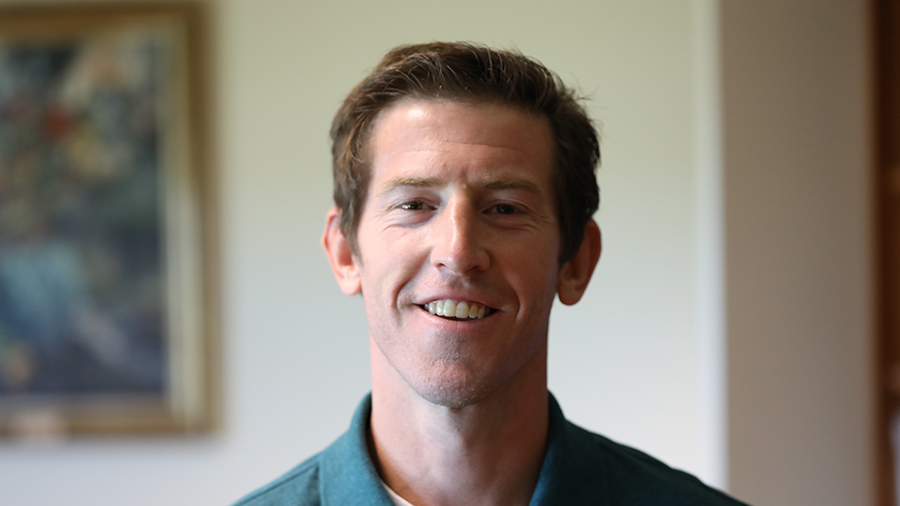Baylor Study Evaluates Biodiversity Impacts of Alternative Energy Strategies

Ryan McManamay, Ph.D., led a study on the potential tradeoffs between climate benefits and energy costs related to biodiversity. (Robert Rogers/Baylor University)
Baylor researcher Ryan McManamay considers ecosystem footprint of climate mitigation energy pathways
Media Contact: Kaitlyn Rieper, Baylor University Media and Public Relations, 254-405-9110Follow us on Twitter: @BaylorUMedia
WACO, Texas (July 13, 2021) – Climate change mitigation efforts have led to shifts from fossil-fuel dependence to large-scale renewable energy. However, renewable energy sources require significant land and could come at a cost to ecosystems. A new study led by Ryan McManamay, Ph.D., assistant professor of environmental science at Baylor University, evaluates potential conflicts between alternative energy strategies and biodiversity conservation.
The study, published in Biological Conservation, evaluates potential tradeoffs between climate benefits and energy costs, especially any negative impacts on biodiversity. While the environmental consequences of some renewable energy sources, like hydropower, have been widely studied, the large-scale impacts of other renewables, like solar, aren’t well known.
“The study points to a need for the global community to understand the opposing endpoints of sustainability, which are scale-dependent,” McManamay said. “At one endpoint, efforts to mitigate climate change at global scales via large-scale energy transitions may be completely incognizant of the consequences on local biodiversity. Likewise, local conservationists may not appreciate the magnitude of energy transitions required to shift global carbon emissions. Finally, I think there is a broad misconception among much of the community that if renewable energies are good for climate, they must also be good for the local ecosystem. Energies like solar have the potential to be deployed haphazardly with that mindset.”
The challenges of climate mitigation in relation to different climate policy scenarios are projected in five Shared Socio-economic Pathways (SSPs) — qualitative descriptions of plausible alternative socio-economic development in the next century. The SSPs include alternative projections in deployment of electricity generations by technology. Considering scenarios under the SSPs, ecological footprinting was used to evaluate the potential land and biodiversity tradeoffs of 10 different energy sources: solar photovoltaic, concentrated solar power, wind, hydropower, coal, conventional oil, conventional gas, unconventional oil, unconventional gas, and biomass.
“Ecological footprinting took into account land-use efficiencies of each technology as well as estimates of the degree of habitat alteration arising from technology deployment,” McManamay said. “This provides a standardized way to compare the biodiversity consequences of large-scale deployment of alternative energy technologies.”
Researchers estimated a biodiversity footprint for each of the 10 energy sources by overlaying energy densities and habitat alteration probabilities with biodiversity patterns. They then used spatial modeling to examine regional variations in future energy deployment and potential biodiversity impacts at a high-resolution. Different biodiversity footprints were scored based on their impact and a cumulative biodiversity score was determined for each of the 10 energy sources.
The cumulative impact scores among the SSPs showed significant and consistent differences — the fossil-fueled development pathway (SSP 5) had the highest impacts while the regional rivalry scenario (SSP3) had the lowest. The sustainability-focused scenario (SSP1) represented a moderate impact score by comparison. Unexpectedly, the variation among SSPs didn’t show a clear tradeoff between global climate mitigation and cumulative biodiversity impact.
“It was surprising to see the lack of a clear tradeoffs among sustainability endpoints,” McManamay said. “This elicited us to take a deeper look into differences among the SSPs. Although SSP5 is termed ‘fossil-fueled’ development, the pathway includes significant technological advances in both advanced fossil and renewable technologies to meet highly consumptive, energy-luxurious lifestyles. In other words, the biodiversity impacts are more related to total energy deployment than fossil versus renewable technologies. Although SSP1 is also characterized by significant renewable energy deployment, overall energy demand decreases due to increases in energy efficiencies. So, our work suggests that climate mitigation may not necessarily have to be at odds with biodiversity conservation.”
Additionally, land constraints accounted for the most variation in biodiversity impact, particularly with regard to protected land use. Downscaled electricity generation scenarios were constrained by alternative land conservation and energy development policies.
The results offer an approximation of land and biodiversity impacts of future energy strategies outlined in the SSPs. While there were differences in the SSPs, the impact scores suggest that land protection measures and energy diversification could have greater implications for biodiversity challenges than the national-level global energy pathways outlined in the SSPs. Future planning and objectives for climate mitigation will require both broad and local consideration of biodiversity challenges.
*Chris R. Vernon of the Pacific Northwest National Laboratory, and Henriette I. Jager of the Oak Ridge National Laboratory are co-authors of the study.
ABOUT BAYLOR UNIVERSITY
Baylor University is a private Christian University and a nationally ranked research institution. The University provides a vibrant campus community for more than 19,000 students by blending interdisciplinary research with an international reputation for educational excellence and a faculty commitment to teaching and scholarship. Chartered in 1845 by the Republic of Texas through the efforts of Baptist pioneers, Baylor is the oldest continually operating University in Texas. Located in Waco, Baylor welcomes students from all 50 states and more than 90 countries to study a broad range of degrees among its 12 nationally recognized academic divisions.